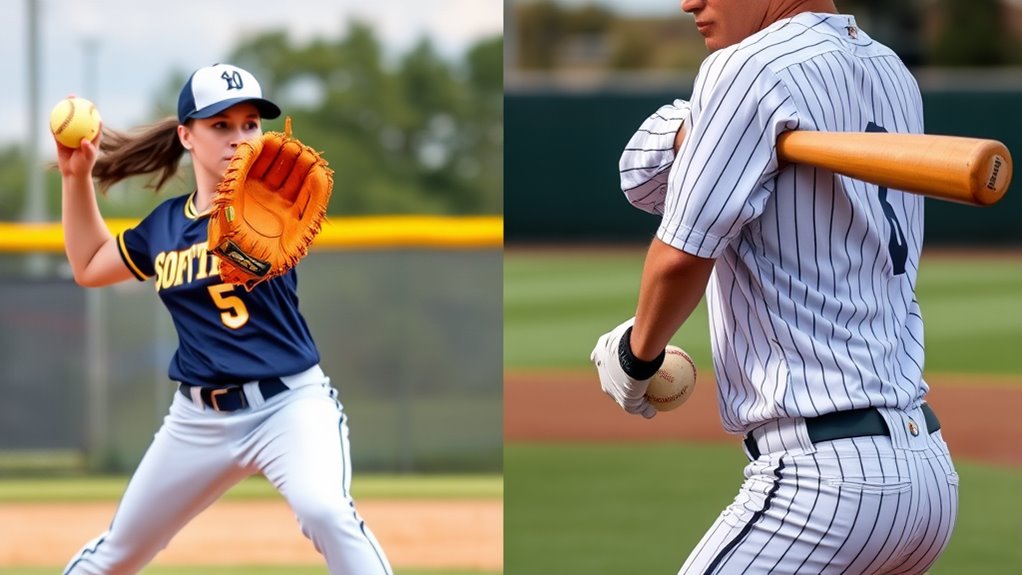Softball and baseball differ in several ways, which impact how you play each sport. Softballs are larger and played with softer equipment, while baseballs are smaller with stiffer gear. The fields also differ in size, with softball fields being smaller and bases closer together. Pitching styles vary, with softball using underhand throws and baseball overhand pitches. Games are shorter in softball, typically seven innings, compared to nine in baseball. Understanding these differences helps you adapt your skills—keep exploring to learn more about each sport’s unique aspects.
Key Takeaways
- Softballs are larger (about 12 inches circumference) and played with softer, more flexible gloves, unlike smaller baseballs and stiffer gloves.
- Softball fields are smaller with bases 60 feet apart, while baseball fields have 90-foot bases and larger dimensions.
- Softball pitching involves underhand wind-up with a circular motion, whereas baseball uses overhand or three-quarter arm throws.
- Softball games typically last 7 innings, shorter than baseball’s 9 innings, affecting game pace and strategy.
- Infield positions are similar, but softball emphasizes quicker plays due to smaller field size and faster game tempo.
Ball Size and Equipment Differences

Softballs are noticeably larger than baseballs, with a circumference of about 12 inches compared to 9 inches. This size difference affects your equipment choices. For softballs, you’ll need a glove made from softer, more flexible materials like leather or synthetic leather, which accommodate the larger size and help you catch more comfortably. Baseball gloves tend to be smaller and stiffer, designed for a 9-inch ball. When selecting a bat, consider its weight; softballs generally require a lighter bat for better control, often around 10 to 12 ounces, while baseball bats can be heavier, typically between 20 and 30 ounces. These equipment differences are essential for handling the respective ball sizes and ensuring proper performance on the field. Additionally, understanding the equipment differences can help beginners improve their game and comfortably transition between sports.
Field Dimensions and Layout
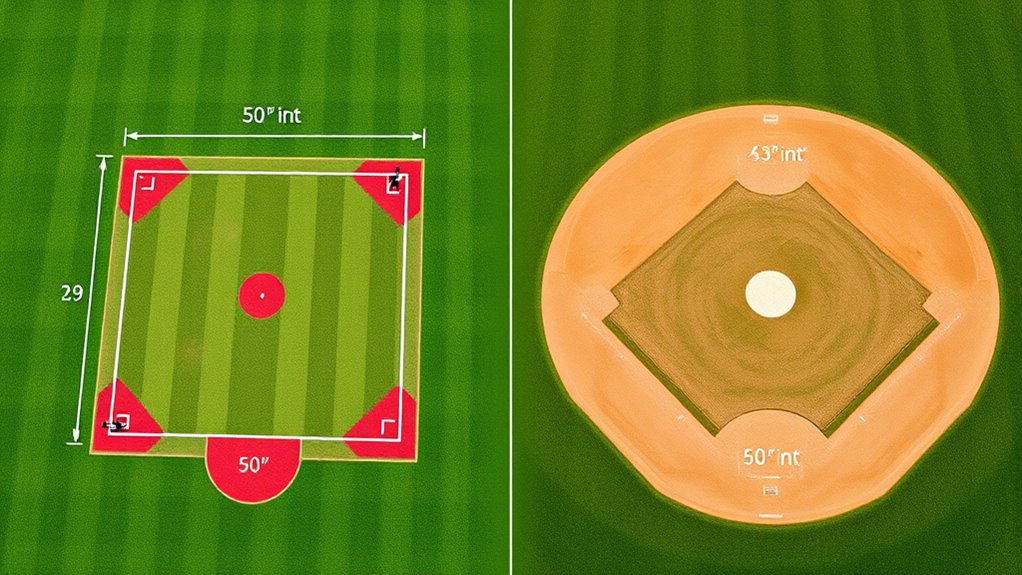
While both softball and baseball fields share similar features, their dimensions and layouts differ markedly, impacting gameplay and strategy. Softball fields are smaller, with shorter distances between bases and closer fencing. Baseball fields typically have bases 90 feet apart, while softball bases are 60 feet apart. Fencing distances also vary: softball fields usually have fences 200-300 feet from home plate, whereas baseball fences extend 300-400 feet. Field markings are vital for defining foul lines, batter’s boxes, and the infield. Here’s a quick comparison:
| Feature | Softball | Baseball |
|---|---|---|
| Base Path | 60 feet | 90 feet |
| Fencing Distance | 200-300 feet | 300-400 feet |
| Infield Size | Smaller, tighter space | Larger, more open space |
| Field Markings | Clear, compact markings | Extensive markings |
| Overall Layout | More compact, closer infield | Larger, expansive layout |
Additionally, the field dimensions are designed to accommodate different pitching styles and player movements, further emphasizing the distinct nature of each sport.
Pitching Styles and Technique
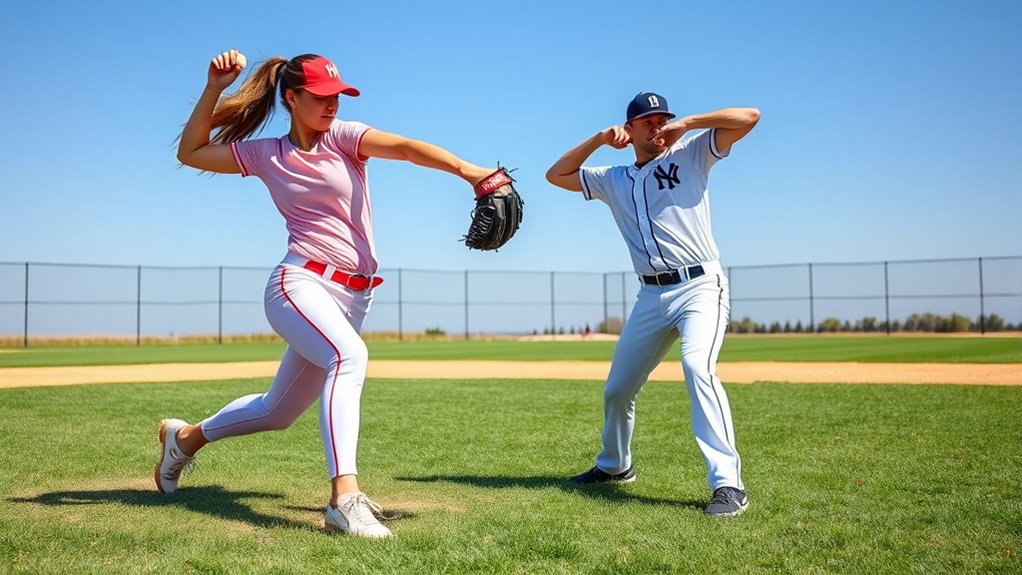
Pitching styles and techniques in softball and baseball differ markedly, shaping how each game is played and how pitchers approach their roles. In softball, you’ll often use a wind-up technique that emphasizes a smooth, circular motion to generate momentum. Your pitching grip might be lighter and more flexible for better control, especially with the underhand delivery. In baseball, the overhand or three-quarter arm angle is common, with a focus on power and deception. Here are key differences:
- Softball pitchers typically employ a wind-up technique for consistent delivery.
- Baseball pitchers often use an overhand or three-quarter arm angle.
- Grip variations in softball help control the ball’s movement.
- Baseball relies more on arm strength and velocity.
- Pitching styles in both sports are tailored to optimize performance and adapt to different rules and game dynamics.
Knowing these differences helps you understand each game’s unique pitching approach.
Game Length and Structure
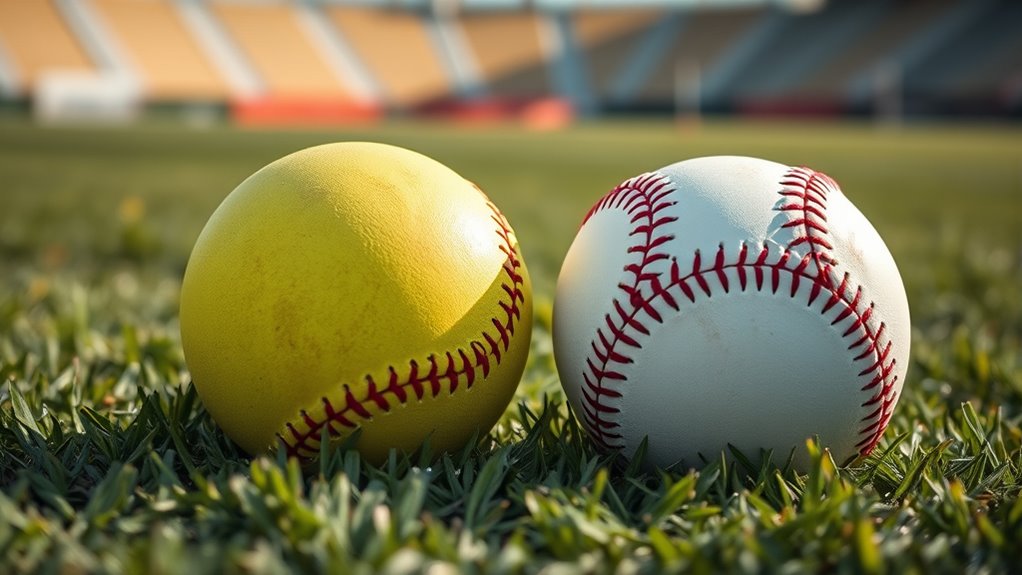
The game lengths and structures of softball and baseball differ considerably, influencing how each sport is played and strategized. In softball, games usually last about 7 innings, with a shorter game duration overall. Baseball games typically extend to 9 innings, creating a longer game duration and more opportunities for scoring. The inning structure in both sports involves teams taking turns to bat and field, but the number of innings directly affects how the game unfolds. Softball’s shorter format often leads to a faster-paced game, requiring quick decision-making and aggressive plays. In contrast, baseball’s longer structure allows for more strategic depth and endurance. Understanding these differences helps you anticipate the flow of each game and prepare for the unique pacing and strategic elements involved. Resources such as training guides can provide additional insights into the strategic nuances of each sport.
Player Positions and Roles
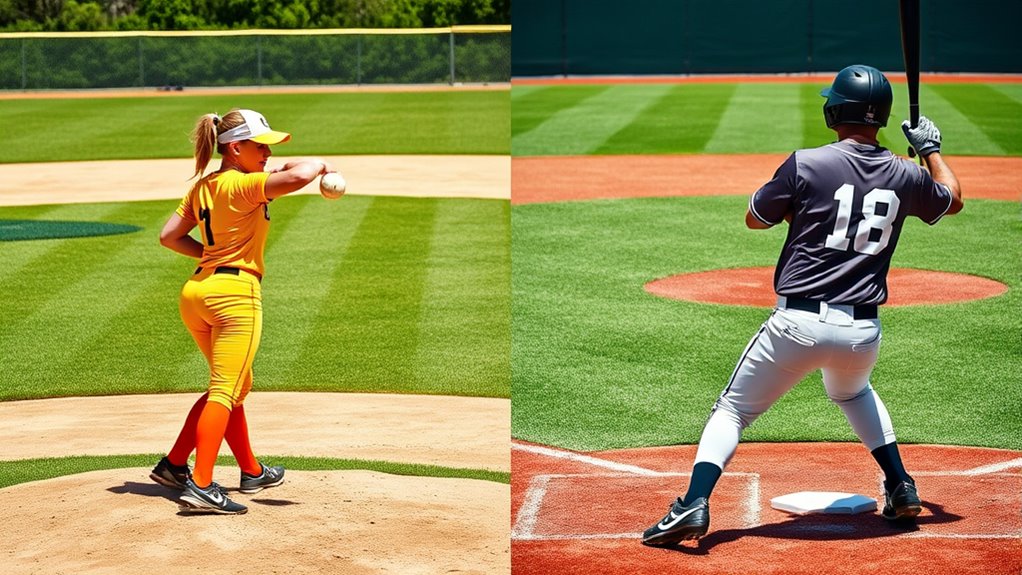
Player positions and roles in softball and baseball are fundamental to how each game is played, with specific responsibilities assigned to each position on the field. Your infield defense focuses on quick reactions and precise throws, covering positions like first base, second base, shortstop, and third base. As a batter, your role varies based on your position in the lineup, influencing your approach at the plate. You can expect: – The pitcher to control the pace and set up plays – The catcher to guide infield defense and handle pitches – Outfielders to cover large gaps and catch long hits – Infielders to work together on ground balls and double plays. Understanding these roles helps you grasp how the game flows and how each position contributes to your team’s success. Proper positioning and communication are crucial for effective defense, which can be enhanced by understanding fielding techniques and strategies.
Frequently Asked Questions
Which Sport Is Easier for Beginners to Pick Up?
You might find softball easier to pick up for beginners, thanks to its equipment comparison—lighter bats and larger balls make handling simpler. Playing strategies can also be more straightforward since the game emphasizes throwing and catching skills over complex tactics. With a slower pitch speed and closer bases, softball often feels more accessible, helping newcomers build confidence and develop fundamental skills before moving on to baseball’s more challenging aspects.
How Do Scoring Rules Differ Between the Two Sports?
While scoring rules might seem straightforward, they differ in subtle ways. In softball, you earn points when your team completes a run by safely touching all bases, with shorter games often leading to quicker point calculations. Baseball, on the other hand, involves more complex scoring methods, including potential for multiple runs per inning. These nuances can influence how you perceive game pace and strategy, making each sport uniquely engaging.
Are There Specific Safety Concerns Unique to Each Game?
You should be aware that safety concerns vary between softball and baseball. In softball, you’ll need protective gear like face masks and gloves due to the faster ball speeds, especially for pitchers and infielders. Field safety is vital in both sports, so check for proper field maintenance and clear boundaries. Always wear the recommended protective gear and stay alert to prevent injuries, ensuring a safe, enjoyable game.
Can Players Switch Between Softball and Baseball Easily?
Switching between softball and baseball can be tricky due to cross training challenges and equipment compatibility. You might find that your skills don’t automatically transfer because of differences in pitching styles, ball size, and field dimensions. While some players adapt quickly, others need time to adjust to new equipment and gameplay. Overall, it’s doable, but expect a learning curve as you get used to the unique demands of each sport.
Which Sport Has a Higher Injury Risk for New Players?
Imagine stepping into a lively game where every swing and catch feels like a dance. You might find that softball has a slightly higher injury risk for new players, mainly due to the larger ball and closer field. To stay safe, focus on injury prevention by wearing proper protective gear and practicing good techniques. This way, you can enjoy the game while reducing the chances of bumps and bruises.
Conclusion
Think of softball and baseball as two different melodies—each with its own rhythm and tune. By understanding these key differences, you’ll be better prepared to step onto the field with confidence. Whether it’s the size of the ball or the style of pitching, knowing what sets them apart is like having the right playlist for your game. So, gear up and embrace the unique rhythm of each sport—you’re about to hit a home run in understanding them both.
